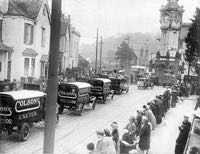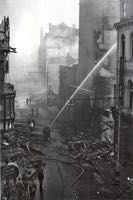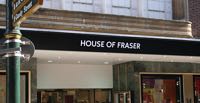
Colsons, Dingles and now The House of Fraser
Page updated 10th May 2016
Return to Retail Exeter
 Colsons, and later, Dingles
have been a part of
Exeter for more than 200 years. They have always been based in the same
place in the High Street and have gone through several rebuildings, and
introduced the first escalator to Exeter.
Colsons, and later, Dingles
have been a part of
Exeter for more than 200 years. They have always been based in the same
place in the High Street and have gone through several rebuildings, and
introduced the first escalator to Exeter.
It was in 1792, when a widow, Mrs Colson, a milliner opened a store selling among other things, silk and tea. Her husband had been a member of King George III diplomatic service. Her son, Mr John Worthy Colson joined the business, adding a linen section. In 1829, he took another partner into the business, becoming Colson and Spark.
In 1854, Colson and Sparks were involved in collecting and compressing into bales, donated lint and old linen to be sent to the hospitals treating British troops in the Criea.
In 1870, John Colson (son of John Worthy Colson who died in 1866), formed another partnership and the store became known as Colson and Gates. In 1887, his eldest son George, took over the business. In the same year George became Sheriff of Exeter. Also in 1887, Colsons had a macabre increase in trade when they gave their entire stock of calico to wrap the bodies of the victims, after the Theatre Royal fire in Longbrook Street, which killed 186.
The 1897 entry in Kelly's Directory for Colson's reads:
"Colson & Company drapers, silk mercers, milliners, costumiers, mantle makers, ladies' & children's outfitters, furriers, hosiers & undertakers, 33 & 34 High st"
A report in the Western Times for Christmas 1902 gives an idea of some of the goods the store sold.
There no lack of pretty and suitable things to be seen at the shop of Messrs. Colson and Co. Every woman will relish the beautiful linen, the downy cushions, the eider-down quilts, and exquisite embroideries, of which they have such a lavish display. Everything that is new and elegant in the way of furs is to be found at this establishment—pointed fox, skunk, ermine, sables, and Persian paw being conspicuous amongst others. An entirely new innovation, moleskin plush, is to be seen in their window. It makes a stylish garment, and would ,no doubt, be a novel and acceptable present. Laces of every kind on are view.
The architect James Crocker FRIBA was chosen for the substatntial update to the premises in 1903, which doubled the frontage to the High Street. The relatively new steel girder was employed in the design along with fireproof ceilings, and thick party walls to prevent the spread of fire. Messrs Ham and Passmore were contracted for the construction work, with internal decorative carvings by Mr Carwardine.
121 years of trade ends for the Colson's
In 1913, the business was bought by the Exeter JP, Sir Edgar Plummer who ran the store for 12 years before selling it to Bright's of Bournemouth in 1925. The trading name of Bright and Colson Ltd was born, with Plummer remaining on the board.
The War Years are a drag!
During the war years, Colsons continued to trade - whether their window displays were special is difficult to say, but it is known that Danny la Rue, who was evacuated to Kennford at the start of the war, worked in the bakery for Colsons, before defecting to Waltons to become a window dresser, across the road.
The blitz of 4 May 1942 proved to be a dramatic time for the business. During the raid, the Church Army Home through to H E Williams in Catherine Street, at the back of Colsons were hit by a high explosive bomb. Also the building next to Colsons in the High Street was destroyed by incendiary bombs.
At 17.26 on the 4th May a call went out from Column Officer Lyne, based in Cathedral Close,
"send Turntable Ladder immediately to Colsons - relay will be available on arrival".
The bomb damaged premises around Colsons had succumbed to the flames and the fire spread into the top floor and roof of the store. The rest of the building was only saved by the timely action of the fire services and a 4ft 6in cob wall that held the flames back.
Rebuilding in stages
There was much that survived of a rather handsome, if architecturally mixed building after the bombing. Indeed, in comparison with the businesses all around, Colsons had escaped lightly. The western end of the store had a rather fine bow window on the first floor that protruded over the pavement. The undamaged parts of the store continued to trade until after the war. Plans were made between 1949-50 to alter the existing premises, but in the end the decision was made to start again.
In 1953, plans were drawn up by Dix's Field architect F W Beech & E Curnow Cookes to replace the whole of the store in nine stages, to create as little disruption to trade as possible. The rebuilding, was done by M T Sleeman and Son, on an expanded site that had included the former shops of Bellmans and Wymans. This new store was the first in Exeter to have an escalator installed. The curved wall at the rear of the premises was the only feature that survived from the old building. In 1960, the J J Allen group took over Colsons and added the Maryon Fashion Group Ltd and Chanelle Ltd to the store. They also incorporated other internal shops such as Danimac, Weatherall and the wine store, Harveys. In 1966 they opened a Food Hall.
The House of Fraser
It was in 1969 that the last takeover of Colsons occurred when the House of Fraser, the parent group of Harrods took control, at a cost of £5.3 million. In 1971, the House of Fraser purchased the rival west country group E Dingle and Co. The Colsons name was changed to Dingles, in September 1973.
With the building of the new Princesshay 'streetscape' (shopping centre to you and me) it was decided to spend £1.5 million to upgrade Dingles to meet the new competion from the much larger Debenhams. At the same time, the name Dingles was dropped and the House of Fraser adopted in September 2007.
Exeter Memories - Colsons or Dingles
│ Top of Page │





